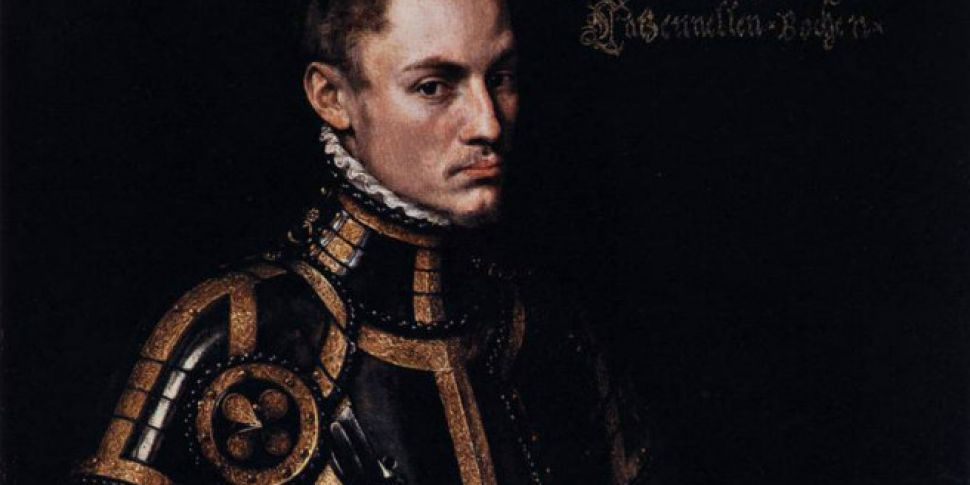As long as he lived he was the guiding star of a whole brave nation, and when he died the little children cried in the streets – historian J. L. Motley
These words were used to describe the Dutch ‘Father of the Fatherland’; William I, Prince of Orange. Born into a world riven by the Reformation and the Wars of Religion William became the figurehead of the burgeoning Dutch state and the avatar for region’s now famous tolerance. By the time of his assassination in 1584 William had exerted a strong influence on the course of history and firmly established himself as one of the Netherlands’ greatest citizens.
In 1533 William was born in the German duchy of Nassau. The Reformation was in full swing at this time, with figures like John Calvin and Martin Luther still active across northern Europe, and William was raised Lutheran. When he was eleven, however, William stood to inherit the Principality of Orange on condition that he receive a Roman Catholic education and upbringing. The family agreed and William moved to the Netherlands where he received this prescribed education while the Holy Roman Emperor Charles V acted as regent of Orange.
This was the beginning of a very close relationship between William and the most powerful man in the world. William’s education in the Netherlands had been supervised by Charles’ sister Mary and at eighteen he became a captain in Charles’ cavalry. Over the following years William increased his political and military standing; becoming a commander of one of the Emperor’s armies and a member of the Netherland’s Council of State.
Though due in large part to William’s own ability these gains and offices were a result of Charles’ favouring of the young Prince of Orange. So close was their relationship in fact that the ailing Emperor is reported to have leaned on William’s shoulder during his abdication ceremony. The steeping own of the ailing Emperor proved to be a seminal moment in Dutch history and the life of William as Philip II succeeded his father as King of Spain and Lord of the Netherlands in 1556.
 'Cavalcade of Six Princes from the House of Orange-Nassau' by Willem Jacobsz Delff, 1621
'Cavalcade of Six Princes from the House of Orange-Nassau' by Willem Jacobsz Delff, 1621
In a world gripped by change Philip saw himself as the champion of the Catholic faith and the scourge of those who broke with Rome. One of the chief tools in Philip’s crusade against unorthodoxy was the Spanish Inquisition. Predating the Reformation, this body was designed to regulate Spain’s Catholic communities and police against any religious dissention or false converts. After the Reformation took root, however, this force was aimed at those who adopted ‘heretical’ protestant teachings.
Northern Europe had proved to be ripe ground for the reformed churches. With these faiths growing on the Netherland’s borders, as well as within the state, Philip sent the Inquisition to ensure orthodoxy prevailed in these northern territories. The Inquisition’s mission of protestant eradication and overreliance on torture rankled with the Dutch who had a long history of tolerance and cooperation.
Built on land reclaimed from the ocean much of the Netherlands depended on series of levies and dykes for its very existence. These vital pieces of infrastructure were the shared responsibility of the local communities and it has often been said that these reclamation projects embedded a culture of cooperation in the Netherlanders. Whether because of this culture of tolerance or the growing protestant population, the Dutch opposed the increasing interference of Spain and the Inquisition during Philip’s rule. This disquiet was worsened as Philip attempted to increase the power of the central government and levied high taxes to help meet his military campaigns and debts.
This centralisation and taxation had rankled the merchants and noblemen who ruled the cities and regions of the Seventeen Provinces. Before 1566 this unrest had largely been confined to the political arena where Philip’s administration in the Low Countries was met with open and vocal opposition. Increasing tension over Philip’s crackdown, however, spilled over in the autumn of that year as the growing protestant population attacked Catholic churches; destroying and defacing the iconography which they believed violated the commandment against graven images.
Dutch national anthem, 'Het Wilhelmus' which tells the story of William of Orange
Philip responded to this growing unrest by sending one of his leading generals to placate the Netherlands. Arriving in 1567 Fernando Álvarez de Toledo, ‘The Iron Duke’ of Alba, sat out to discover and prosecute those who had been involved with the rebellions and iconoclasm. His main tool on this quest was the Council of Troubles, whose brutality and lack of clemency soon saw it dubbed the Council of Blood. Alba was quick to exert his iron will over the Netherlands, suppressing revolts and executing many of the leading dissenters.
William might have met a similar end to many of his contemporaries had he heeded the council’s summons to appear before it. Instead William had fled to the safety of Saxony, urging many of his fellow Dutch nobles with protestant sympathies to do the same. It was a conversation eight years previously that had pushed William to run. King Henry II of France, convinced of the Dutchman’s loyalty to Philip and Catholicism, spoke openly with William during a hunting trip about shared Franco-Spanish plans to root out Protestantism in both of their empires.
William’s silence had lulled the French monarch into betraying the full scope of Philip’s hatred for ‘heretics’ and he knew that the Iron Duke’s arrival did not bode well. Though his flight to Germany saw William stripped of his lands and titles and declared an outlaw, it also saved his head and saw him emerge as the champion of the Dutch Revolt. Over the following years William financed and led excursions into the Netherlands with the aim of expelling Alba and his Spanish troops.
William had never been an exemplary military leader, however, and the highly accomplished ‘Iron Duke’ was able to outmanoeuvre and defeat the protestant forces. By the end of 1568 William’s military capabilities were destroyed and by 1570 the Dutch Revolt was all but repressed; only the piratical ‘Sea Beggars’ continued to harass Spain, launching raids on shipping and the Dutch coast from English ports. The Netherlands was far from Spain’s only worry at this time, however.
At sea and abroad Philip was vying for power with England and other growing empires while the war with the Ottoman Empire continued. In an effort to alleviate the strain on the imperial purse strings Philip ordered Alba to finance his mission from taxes levied on the Low Countries. Going against the States General Alba introduced a 10% tax on all sales in 1571. This unpopular levy fomented the dying embers of rebellion and breathed life into the dying Dutch Revolt.
 'The Relief of Leiden' by Otto van Veen, 1574
'The Relief of Leiden' by Otto van Veen, 1574
The following year the ‘Sea Beggars’, expelled from England’s ports, took the Dutch town of Brill. Though far from a major military victory this moment was massively important as towns and cities across the northern provinces of Holland and Zealand declared for the rebels in response. The former governor of these regions, William was reinstated to these positions of power and became the head of the rebellion.
The religious conflict was worsening across Europe at this time. The French Wars of Religion were in full swing and, mere months after the capture of Brill, the streets of Paris ran with blood as Huguenots were butchered during the St Bartholomew’s Day Massacre. Though the Low Countries weren’t free from sectarianism as the rebellion progressed they became increasingly viewed as a tolerant sanctuary.
This tolerance may have had a lot to do with the figure of William. Born into a Lutheran family his conversion to Catholicism was largely pragmatic, a condition of becoming Prince of Orange. In 1573 William’s Protestantism was confirmed as he joined the Calvinist Church. This motley history of belief and his close relationship with leading Protestants and Catholics might well have engendered a philosophy of understanding within William, one that he tried to imbue in his people.
This proved a herculean task, however, as the war for independence raged on and sectarian divisions deepened. Though Alba had been recalled to Spain in ’73 the Dutch path to victory was far from easy. Both sides won decisive victories until a mutiny by Spanish troops in ’76 swung public favour firmly in the rebels’ direction. Rebelling at a lack of pay these mercenary soldiers turned on the loyal city of Antwerp, sacking the city and killing thousands of civilians. The brutality of this event and other mutinies unified the Low Countries against Spain and its mercenary armies. Jan Luycken
 'The capture of Maastricht' by Jan Luycken, 1679
'The capture of Maastricht' by Jan Luycken, 1679
While this unified front posed a great threat to Spanish rule, religious tensions had already begun to erode the union of the Calvinist north and Catholic south. In 1579 this split came to the fore as several southern provinces accepted Spain’s terms with the Union of Arras. Recognising Philip as their king these regions saw their historic privileges returned. In reaction to this the remaining northern provinces signed the Union of Utrecht on the 23rd of January, creating the Dutch state that still exists today.
Though William had opposed this division of the Seventeen Provinces along religious fault lines he was forced to accept the new state. Over the following years William continued to play a large role in the governance and affairs of this fledgling state as it fought for recognition and survival in an increasingly sectarian world. Five years after the Union of Utrecht, however, William was assassinated by the Catholic Frenchman Balthasar Gerard.
While Gerard had hoped to collect the handsome reward promised by Philip II he was captured before he could escape. While William had urged clemency for a previous would be assassin there was no one to urge the same for Balthasar and he was condemned to a brutal death. The sorrow of a nation was meted out on Balthasar as the court ordered his right hand be burned off with a hot iron, his flesh torn from his body, that he be disembowelled and quartered while alive, and that his heart be thrown in his face and his head cut off.
William’s importance to history is hard to quantify. In life he provided a focal point for the Dutch Revolt. Though not the greatest of generals his personality and philosophy helped to unify the disparate people of the Seventeen Provinces, forcing the Spanish to return the rights and privileges to the Union of Arras. Even in death he helped to secure the future of the Netherlands as England and the wider protestant world came to champion the Dutch Republic in the wake of his assassination; securing the existence of the Netherlands in 1648 with the Peace of Münster.
 'The celebration of the peace of Münster' by Bartholomeus van der Helst, 1648
'The celebration of the peace of Münster' by Bartholomeus van der Helst, 1648
Lisa Jardine’s ‘The Awful End of Prince William the Silent’ tells an engrossing story of William’s importance in history and the legacy of his death. C. V. Wedgwood’s ‘William the Silent’still stands out as one of the greatest accounts of this great statesman’s life while Jonathan I. Israel’s ‘The Dutch Republic: Its Rise, Greatness, and Fall’ tells the tale of the state he helped to found.
For a full list of ‘Talking History’ book recommendations click here.









